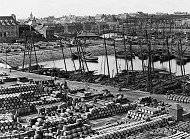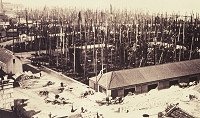Herring Home | Fishing for herring | Back to Expansion of the Herring Fishery
Where did herring fishing take place?
There has been herring fishing off the Scottish East Coast for many hundreds of years. However, it tended to take place inshore and be fairly small-scale. Herring fishing began to grow in the late 18th century. By the late 19th century it was happening on a large scale in Scotland.

The first herring boom occurred in Caithness in the 1790s. Sutherland became involved soon after. There was huge pressure on space at Wick despite the building of Pulteneytown in 1806. In 1808 there were 214 boats using Wick Harbour, and by 1814 there were 822. This caused curers to overspill into smaller settlements along the coast such as Whaligoe and Dunbeath. Wick was the leading port but Lybster and Helmsdale also made significant catches. Caithness reached its peak in the 1850s by which time congestion was a major problem. The success of Caithness encouraged other East Coast communities.

To the south of this area there were many long established East Coast fishing communities. These were generally slower to develop the herring fisheries. This was often because they were already involved in line fishing. The summer herring fishing in East Lothian remained important, although small in scale compared with the new fisheries. Other inshore fisheries continued, such as the Lammas Drave on the Firth of Forth and on the Moray Firth.

Around 1815 the fisheries began to spread along the east coast. By the mid 1830s ports on the south side of the Moray Firth were flourishing. Substantial fisheries were also established at the Aberdeenshire ports of Fraserburgh (from the 1820s) and Peterhead (from the 1830s). From the mid 1830s the fishing fleet began to expand into new areas such as Stonehaven. These ports grew during the century and by the 1870s Fraserburgh had a larger fishery than Wick. This area reached its peak in the 1880s. In Aberdeenshire, congestion was also a problem, so curers set up at smaller ports such as Boddam.
In Fife, small winter fisheries began in the 1820s. In the 1830s it became one of the main areas for the summer fisheries. Successful summer fisheries lasted until the 1860s when the Fife herring fisheries began to decline. However, fishing continued to be important to the area.
During the 1860s and 1870s landings declined in the smaller settlements. This included places such as Lybster, Helmsdale, Buckie and the Firth of Forth. Montrose only began to flourish as a herring-fishing centre in around 1860. Aberdeen became successful a decade later. By the 1870s there was a tendency to concentrate in fewer, larger centres. The three main concentrations were in Caithness, the northeast from Macduff to Montrose and Berwickshire.
At the peak in 1890, about 100 000 people were employed in the Scottish fisheries. About half worked as fishermen while the others working onshore in trades such as gutters, packers and curers.
Herring Home | Fishing for herring | Back to Expansion of the Herring Fishery